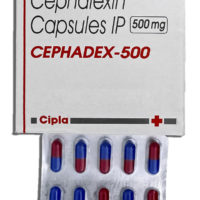| Active substance | Cephalexin |
| US Brand | Keflex |
| IN Brand | Cephadex |
| Manufacturing by | Cipla |
| Strength | 250mg, 500mg |
| Form release | blister 10 capsules |
| Estimated shipping time | 7 – 18 days (Depending from the Country) |
| Availability, Prices & Order | through request form |
Cefalexin, also spelled cephalexin, is an antibiotic that can treat a number of bacterial infections. It kills gram-positive and some gram-negative bacteria by disrupting the growth of the bacterial cell wall. Cefalexin is a beta-lactam antibiotic within the class of first-generation cephalosporins. It works similarly to other agents within this class, including intravenous cefazolin, but can be taken by mouth.
Cefalexin can treat certain bacterial infections, including those of the middle ear, bone and joint, skin, and urinary tract. It may also be used for certain types of pneumonia, strep throat, and to prevent bacterial endocarditis. Cefalexin is not effective against infections caused by methicillin-resistant Staphylococcus aureus (MRSA), Enterococcus, or Pseudomonas. Like other antibiotics, cefalexin cannot treat viral infections, such as the flu, common cold or acute bronchitis. Cefalexin can be used in those who have mild or moderate allergies to penicillin. However, it is not recommended in those with severe penicillin allergies.
Common side effects include stomach upset and diarrhea. An allergic reaction and infection with Clostridium difficile, a type of diarrhea, is also possible. To date, no evidence of harm to the baby has been found when used during pregnancy or breast feeding. It can be used in children and those over 65 years of age. Those with kidney problems may require a decrease in dose.
In 2012, cefalexin was one of the top 100 most prescribed medications in the United States. In Canada, it was the 5th most common antibiotic used in 2013. In Australia, it is one of the top 15 most prescribed medications. Cefalexin was developed in 1967. It was first marketed in 1969 and 1970 under the names Keflex and Ceporex, among others. Generic drug versions are available under several other trade names and are inexpensive. Cefalexin is on the World Health Organization’s List of Essential Medicines, the most effective and safe medicines needed in a health system.
Usual Adult Dose for Bacterial Endocarditis Prophylaxis
2 g orally as a single dose one hour before the procedure
Usual Adult Dose for Cystitis
250 mg orally every 6 hours or 500 mg orally every 12 hours for 7 to 14 days
Usual Adult Dose for Otitis Media
500 mg orally every 6 hours for 10 to 14 days
Usual Adult Dose for Pharyngitis
250 mg orally every 6 hours or 500 mg orally every 12 hours
Usual Adult Dose for Skin or Soft Tissue Infection
250 mg orally every 6 hours or 500 mg orally every 12 hours
Usual Adult Dose for Osteomyelitis
500 mg orally every 6 hours
Therapy should be continued for approximately 4 to 6 weeks, depending on the nature and severity of the infection. Chronic osteomyelitis may require an additional one to two months of antibiotic therapy and may benefit from surgical debridement.
Usual Adult Dose for Prostatitis
500 mg orally every 6 hours for 14 days
Usual Adult Dose for Pyelonephritis
500 mg orally every 6 hours for 14 days
Usual Adult Dose for Upper Respiratory Tract Infection
250 to 500 mg orally every 6 hours for 7 to 10 days
Usual Adult Dose for Bacterial Infection
250 to 500 mg orally every 6 hours
Therapy should be continued for approximately 7 to 21 days, depending on the nature and severity of the infection.
The most common adverse effects of cefalexin, like other oral cephalosporins, are gastrointestinal (stomach area) disturbances and hypersensitivity reactions. Gastrointestinal disturbances include nausea, vomiting, and diarrhea, diarrhea being most common. Hypersensitivity reactions include skin rashes, urticaria, fever, and anaphylaxis. Pseudomembranous colitis and Clostridium difficile have been reported with use of cefalexin.
Signs and symptoms of an allergic reaction include rash, itching, swelling, trouble breathing, or red, blistered, swollen, or peeling skin. Overall, cefalexin allergy occurs in less than 0.1% of patients, but it is seen in 1% to 10% of patients with a penicillin allergy.
